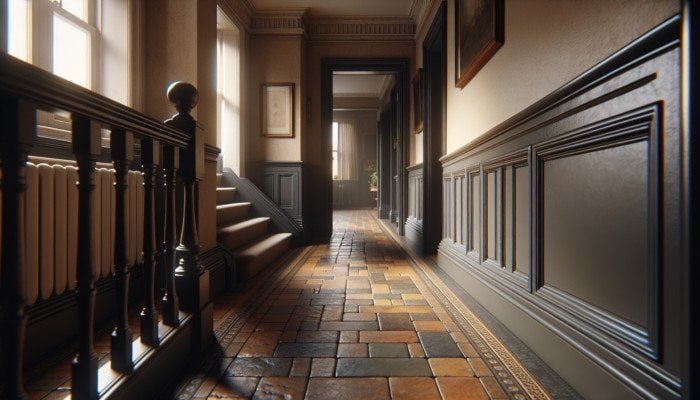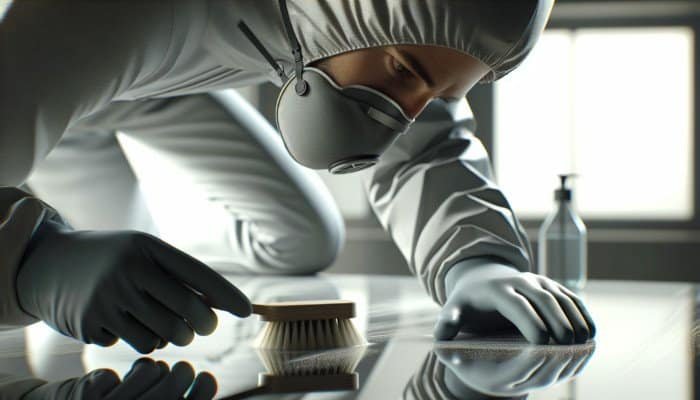


24 May 2025 by
sitemanager
Restoring quarry tile flooring is akin to giving your beloved floor a revitalising transformation—imagine fitting a robust raincoat over your cherished coat. These unglazed clay tiles, historically utilised in Victorian hallway designs and garden patios, marry historic elegance with exceptional longevity. In Richmond upon Thames, where the restoration of period property flooring pays homage to our architectural legacy, revival consistently triumphs over replacement.
At Fabritec Tile Cleaning in New Malden (01372-664-337), we have witnessed numerous homes undergo stunning transformations. Rather than discarding charming flooring concealed beneath carpets or vinyl, our gentle bitumen removal techniques and clay floor revival methods unveil the inviting terracotta tones hidden below. Restoration is not only financially savvy over time, but also an artistic endeavour that upholds the unique character of listed building flooring.
This comprehensive guide will navigate you through each phase, from the initial inspection to the application of a breathable tile sealer, ensuring your tiles not only look stunning but also remain slip-resistant. By the conclusion, you will grasp how traditional floor finishes and eco-friendly cleaning solutions synergise to safeguard your heritage flooring for generations to come. [Insert Internal Link to Related Article]

Quarry tiles are unglazed clay tiles celebrated for their natural, matte finish and remarkable durability. Unlike contemporary ceramic tiles adorned with glossy glazes, these clay quarry tiles feature a porous, earthy texture that matures beautifully—similar to how a well-loved leather armchair gains character as time passes.
Within Richmond residences, you will frequently encounter them in:
The key distinctions from modern tiles include:
| Feature | Quarry Tiles | Modern Ceramic |
|---|---|---|
| Porosity | High – facilitates breathability | Low – can retain moisture |
| Durability | Extremely hard-wearing | Susceptible to chipping when glazed |
| Finish | Matte, unsealed floor tiles | Glossy or satin glaze |
Due to their unsealed nature, quarry tiles necessitate proper tile sealing or a beeswax finish to protect against stains and efflorescence. In older UK homes lacking damp-proofing, breathable sealers are vital for preventing moisture entrapment beneath quarry tiles, which is essential for maintaining long-term floor integrity. [Insert Internal Link to Related Article]
Richmond upon Thames boasts an array of period properties, including Georgian townhouses and Edwardian cottages, which frequently conceal hidden treasures beneath modern coverings. These period home floors were originally crafted with quarry tiles arranged in intricate geometric patterns, offering both durability and aesthetic appeal. Visualise them as a timeless tapestry, woven from local clay and the historic kiln traditions of the area.
Prominent locations such as Kew Gardens and nearby conservation areas showcase traditional tilework—demonstrating how historic flooring styles continue to be cherished in both public and private settings. In neighbourhoods like St Margarets, many older village shops may still feature original flooring—often a prized aspect admired by enthusiasts of Victorian home restoration.
Preserving these floors transcends mere aesthetics; it pays tribute to Richmond’s architectural history and sustains the essence of your home. By choosing restoration over replacement, you honour the distinctive character that renders your property exceptional, safeguarding both its aesthetic and historical significance. [Insert Internal Link to Related Article]
Revitalising quarry tiles involves a meticulous combination of assessment, cleaning, and protection. Approach it as you would preparing a cherished wooden table for varnishing—you wouldn’t overlook the essential steps of sanding or dusting. Adhere to these guidelines for dependable historic floor repair in your Richmond residence.

Utilise a soft-bristled brush or vacuum to eliminate loose grit. Refrain from using water at this stage to prevent the clay tiles from absorbing excess moisture.
Apply an eco-safe cleaning product or a specialised bitumen remover. Allow the product to dwell for the recommended time, then carefully scrape away residues. For particularly stubborn substances, repeat the process rather than intensifying chemical use.

Employ a pH-neutral or slightly alkaline clay tile cleaner diluted according to the manufacturer’s instructions. Agitate with a soft brush to lift ingrained dirt without causing surface damage.
Ensure adequate ventilation and a suitable ambient temperature. Avoid forced heating as it can trap moisture beneath, potentially leading to future damage.
Prepare lime mortar to a workable consistency and fill any gaps. This traditional material adapts with the tiles, preventing cracking.
In thin layers, apply a breathable tile sealer or beeswax finish. This protective ‘raincoat’ for your floor shields against stains while allowing moisture to escape. [Insert Internal Link to Related Article]
Even seasoned DIY enthusiasts can fall victim to simple mistakes that undermine quarry tile restoration. Sidestep these tile restoration pitfalls to safeguard your investment and maintain the character of your heritage flooring.
By avoiding these DIY floor sealing blunders, you will ensure that your Richmond upon Thames quarry tiles remain both stunning and functional for years to come. [Insert Internal Link to Related Article]
Even with the utmost care during restoration, you may encounter missing or irreparably damaged tiles. Fortunately, Richmond upon Thames offers excellent sources for acquiring reclaimed quarry tiles that complement the original character of your flooring.
When selecting replacements, consider:
| Criteria | What to Check |
|---|---|
| Colour match | Compare under natural daylight, rather than solely relying on showroom lighting. |
| Thickness & size | Ensure tolerances are within 2–3 mm to avoid uneven flooring. |
| Surface wear | The patina level should be consistent with your restored tiles. |
By procuring from reputable salvage yards and online heritage tile suppliers, you will uphold the authenticity of your period home floors and ensure seamless integration. [Insert Internal Link to Related Article]
Once your quarry tiles are meticulously restored and sealed, establishing a straightforward care routine is crucial for preserving their allure. Think of maintenance as akin to regularly oiling leather boots—small actions can avert larger problems in the future. With consistent clay tile care, your floors will retain their warmth and slip resistance for many years.
Begin with weekly maintenance:
Seasonal inspections (every 6–12 months) are vital for early wear detection:
Avoid steam mops, acidic cleaners, or abrasive pads—these can strip sealers and damage tiles. Consistent, gentle care ensures that your Richmond upon Thames heritage flooring remains a warm, inviting feature of your home. [Insert Internal Link to Related Article]